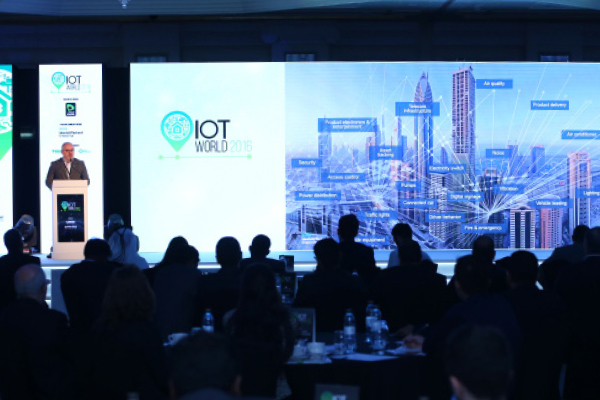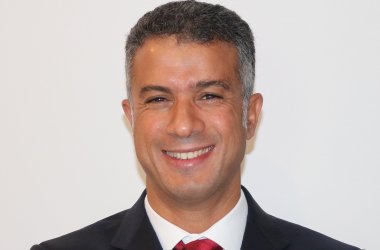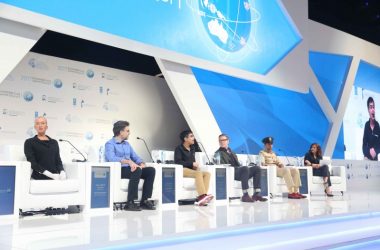Last month, CNME hosted the inaugural edition of its IoT World conference at the Habtoor Grand Hotel in Dubai, to discuss one of the biggest trends that is transforming the IT landscape – the Internet of Things.
The Internet of Things has the promise to make everything more intelligent and efficient. Smart grids, meters and cars are just a few examples of innovations that will transform our societies in years to come.
While the concept of connected things is nothing new, there is undoubtedly a huge amount of work to be done in the Middle East. With 150 IT decision-makers, analysts and tech aficionados in attendance, the IoT World conference delved into how IoT can transform the way people live and work.
The first speaker of the day was David Garcia-Torre, director, solution marketing IoT, Etisalat, who discussed the importance of machine to machine (M2M) learning and IoT, and how organisations can better utilise information to make better business decisions. “As the line between physical and digital worlds continues to blur, we believe that M2M solutions and IoT technologies are key for enterprises to succeed in the impending digital era,” he said.
Torre then highlighted Etisalat’s plans to create a dedicated IoT network to power various smart initiatives in the UAE. “We are working on a low-powered wide area network technology that will enable us to offer large scale reliable and secure connectivity for IoT services, as well as pave the way to build a Smart UAE,” he said. “This technology will enable Etisalat to introduce IoT solutions for mass connectivity of various machines and devices, ranging from smart meters to multiple sensors for vertical industries to fulfil requirements of the country’s Smart City vision.”
Sania Abbas, business unit executive, IBM Watson Internet of Things, then took the stage to share insights about ‘the cognitive era’. “We are living in a fast-paced environment where everything is constantly evolving,” she said. “Businesses everywhere are increasingly becoming digital, and IoT technologies are speeding up that process even more. Subsequently, this also means that competition is growing across various verticals, which pushes today’s IT and business leaders to be more active in finding and creating new growth opportunities.”
According to Abbas, a key element to successfully finding these new opportunities for growth is digital intelligence. “Digital intelligence is centred around data. There is a tremendous amount of data, both structured and unstructured, that exists in the market today and understanding that data is crucial to be able to fully harness the vast potentials it brings. The cognitive era is your response to that new potential. It’s about outthinking challenges, competitors and limits by sensing opportunities you’d never before imagined. Cognition enables organisations to gain insights to better engage with their customers, gain a significant edge over their competition, and develop new innovations.”
IoT is expected to change the way organisations can do business, as well as the way that consumers experience various products and services. This idea is fuelled by the fact that the physical world is increasingly becoming more digitised, a notion that was underlined by Shamel Janbek, chief enterprise architect, Hewlett Packard Enterprise Middle East. “We are now in the ‘idea economy’ where digital is everything, and everywhere, every day, everyone is becoming more connected,” he said.
He also highlighted that while IoT is not a new concept, industry leaders still haven’t come up with a precise definition of what the Internet of Things is all about. “We can all agree that IoT focuses on three major aspects – devices, data and connectivity,” he said. “First and foremost, it’s about devices – and not just the typical computing devices, it includes everything from tiny sensors to single-application embedded devices like ATMs, smart meters, personal health trackers and so on. Secondly, IoT is also about data. In fact, it’s useful to look at IoT as a new source of data. All of those devices have something to say; their output is data. And the primary value of IoT is in that data because the convergence of analytical insights enabled by connected devices can be used for enhanced decision making, automation, continuous improvement of business processes, and much more – if we can learn how to harness all of that data and transform it into business intelligence.
“Lastly, IoT is about connectivity, because as we’ve all seen, incredible things happen when you connect the unconnected.”
Mehrdad Taherzadeh, CEO, HAL Technology, was next up, and discussed the widespread potential value-adds that could result from fully connected Smart Cities.
“Based on IoT technologies, a Smart City will utilise advanced sensors to monitor and improve numerous functions within a city including transportation, water and waste management, safety and security, even the delivery of education and healthcare,” he said. “Data gathered from these sensors will help city leaders to make better decisions as to how they can advance infrastructures, and, ultimately, the way people live and work.”
Next on stage was Husni Hammoud, CEO, Cradlepoint, who continued the discussion on Smart Cities, highlighting the challenges and opportunities surrounding the different projects in this space. “Public sector leaders across the globe are increasingly implementing IoT technologies like sensors, M2M devices, wireless connectivity and the like,” he said. “The ever-increasing prevalence of the Internet of Things in community operations is taking many Smart City ideas from being a dream to reality. The appetite for intuitive, predictive technology is rising, and forward-thinking executives and IT professionals don’t want to be left behind.”
Hammoud also highlighted that there are currently a multitude of connectivity options for Smart City applications, and choosing the correct solution to increase efficiencies, streamline work process, and enable central management will be key to keeping up with these innovations.
The last presenter of the day was Zoho Corporation’s director of WebNMS, Prabhu Ramachandran, who talked about the importance of IT/OT convergence in succeeding in the IoT era. “Information technology and operational technology were typically viewed as two separate domains of business,” he said. “Smart offices and buildings are expected to make big strides in the next few years. That’s an aspect where we believe IT/OT convergence will play a big role. The IoT era presents an opportunity for enterprises to monitor office utilities in real-time. The data gathered from sensors and applications used by OT systems will enable organisations to increase efficiency and potentially reduce the cost of their operations.”
The event concluded with a lively and thought-provoking panel discussion led by CNME Editor James Dartnell. Panellists included Raees Shaikh, Key Account Manager, Infor; Hammoud; Saadi Kawkji, SE Director, Aruba Networks, an HPE company; Abbas; and Youssef Saidi, COO, Bahri & Mazroei.





